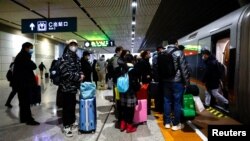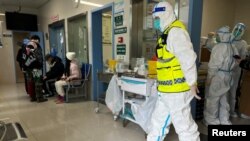Wang Xiaodong lives in Qatar, where he imports Chinese-made construction material. His home on the Arabian Peninsula is thousands of kilometers away from his family's village deep in the mountains of China's southern Yunnan province.
The hamlet is so remote that few of the 600 villagers ever visit a hospital, and just last week, Wang Xiaodong's mother told him that COVID-19 had arrived to infect "everyone in the village." A few people, mostly older folks, died, as did a 17-year-old girl, he told VOA Mandarin.
Wang Xiaodong's village and others like it are worrying Beijing's officialdom as the Lunar New Year approaches and the world's greatest annual home-for-the-holidays migration begins.
The government is acknowledging that the first full-on Lunar New Year celebration since 2019 may cause serious COVID-19 outbreaks in rural areas, where there are fewer medical resources than in the cities, which are struggling to cope with the onslaught of patients and deaths.
During an interview with government-affiliated China Central Television on Sunday, National Health Commission official Jiao Yahui said, "What we are most worried about is that after three years when no one has gone home for the Lunar New Year, this year, we can finally go home for the New Year. If this happens, there may be a retaliatory rush of people from the city to the countryside to visit relatives for the New Year, so we are even more worried about epidemics in rural areas."
According to Chinese state media outlet Xinhua, residents made some 3 billion trips during the Lunar New Year in 2019. The next year, millions of people left Wuhan, where COVID-19 was first detected in humans, for the Lunar New Year. Chinese officials finally began locking down the city on January 23. A few days later, the mayor told reporters an estimated 5 million people had left town before the borders were sealed.
Wang Jian, an independent media professional from central China who now lives in the Boston area of the United States, told VOA Mandarin the holiday migration means that "hundreds of millions of people are on the road. A large population is converging on trains, cars, ships and other means of transportation. This is a very large hotbed of infection."
City people flooding into villages like Wang Xiaodong's pose a risk to populations dominated by older adults and the children whose parents have moved to work in urban areas.
"The real battlefield of Chinese medical care is not in cities, not in Beijing, Shanghai, Guangzhou, Shenzhen, but in the quiet countryside," Wang Jian said. "There are no doctors, no medicines, no medical facilities, no medical resources. If there is a large-scale outbreak, they can only send patients to the city. The problem now is, so far, China, from the central government to the local government, does not have a complete set of plans to save the rural medical system, because it can't manage the cities."
Health official Jiao said that counties and townships must have vehicles ready to transport patients if needed, and that urban and rural hospitals have formed a support network so the high-quality medical resources in cities are available to county hospitals when needed.
Wang Jian called Jiao's remarks "nonsense" as the National Health Commission is not responsible for resource allocation.
He said the townships and the villages lack doctors and medicine and the county hospitals do not have many medical resources.
"Those farmers are not even willing to pay for the car," Wang Jian said. "Chinese farmers are very poor. I believe 60% of them would rather stay at home than pay for medical treatment. If they're not willing to spend money, that means delay in rescue and treatment."
Based on Xiaodong's mother's accounts, the virus, however, seems to have already reached the deepest corners of the country, even without the mass migration for Lunar New Year, which this year runs from January 21 to 27, according to the State Council.
In early December, China relaxed its strict "zero-COVID" policy — a collection of rules that had resulted in almost three years of widespread lockdowns, involuntary quarantines and an economic slowdown — only to face a new set of public health problems connected to a rapid rise in infections.
According to a forecast published on December 28 by Airfinity, a London-based research firm that focuses on predictive health analytics, COVID-19 infections in China are expected to reach the first peak January 13, with 3.7 million cases a day, while deaths are estimated to peak 10 days later, at approximately 25,000 a day.
Adrianna Zhang contributed to this report.

